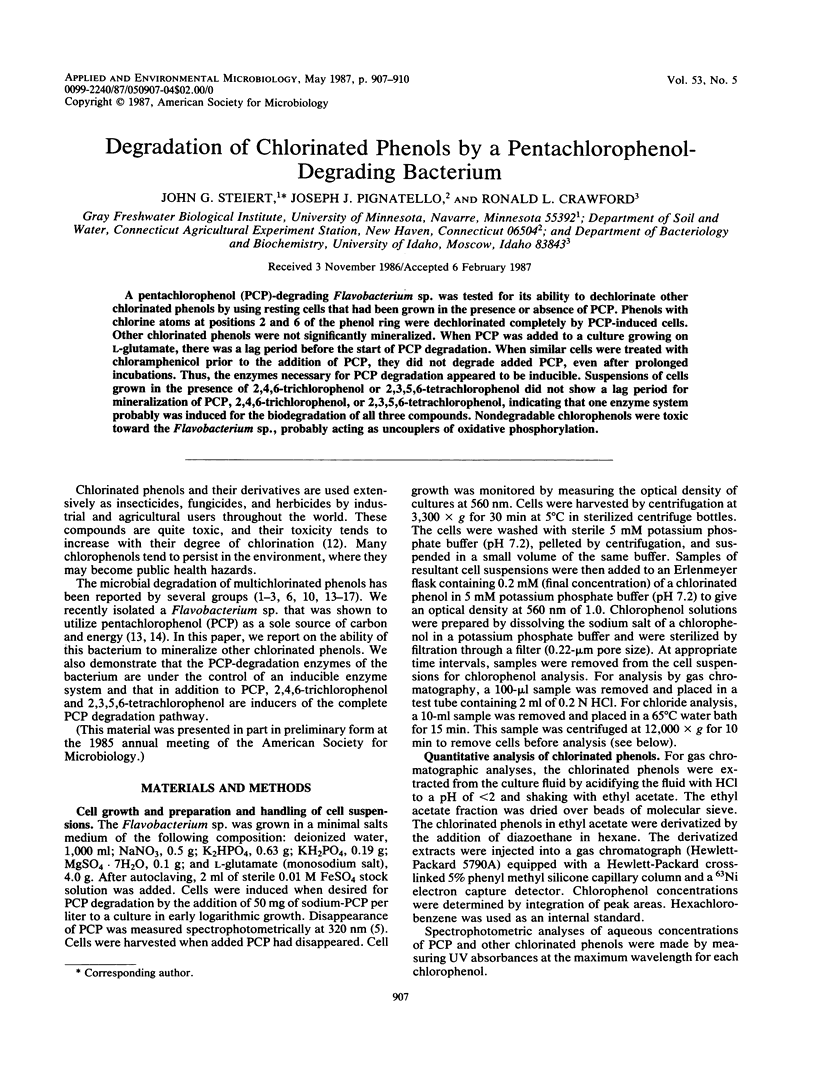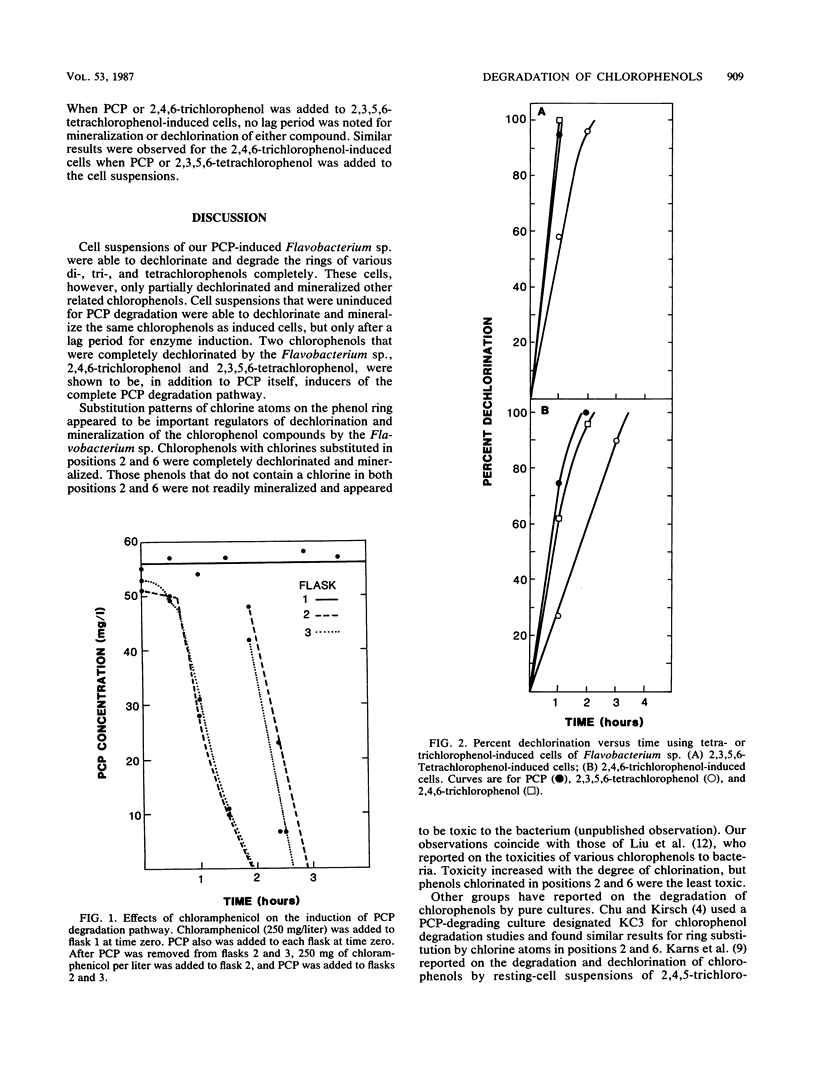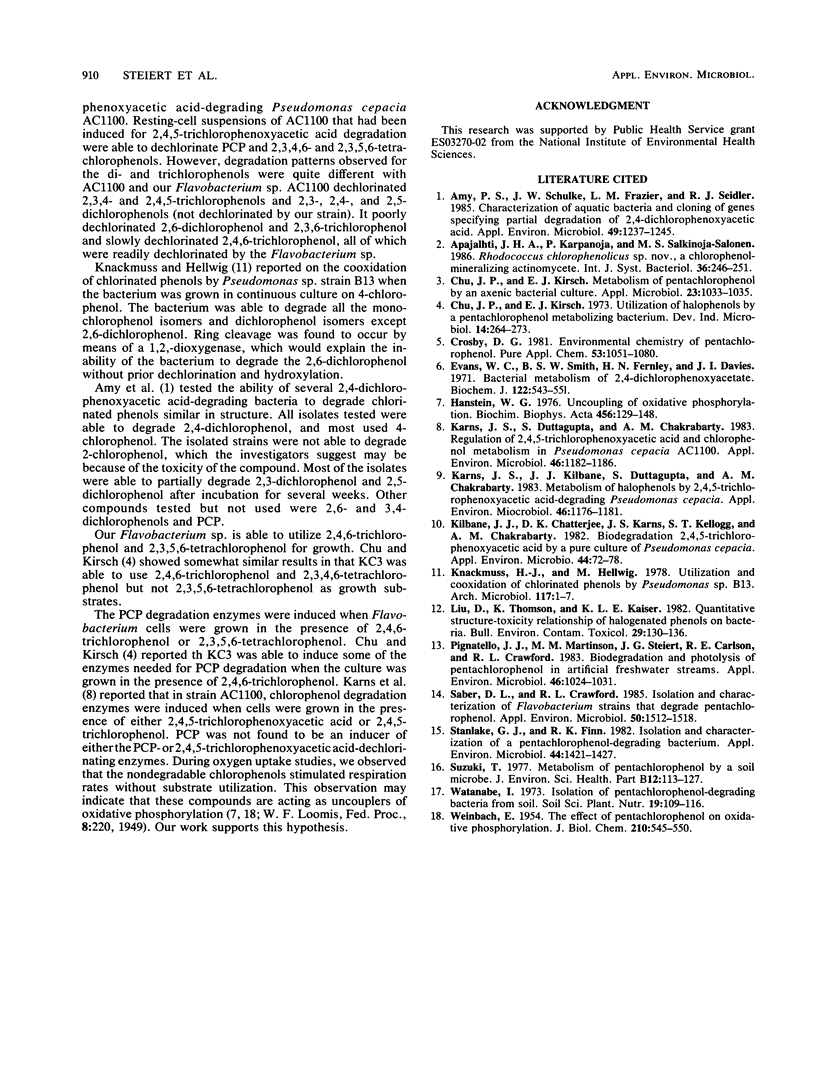Abstract
A pentachlorophenol (PCP)-degrading Flavobacterium sp. was tested for its ability to dechlorinate other chlorinated phenols by using resting cells that had been grown in the presence or absence of PCP. Phenols with chlorine atoms at positions 2 and 6 of the phenol ring were dechlorinated completely by PCP-induced cells. Other chlorinated phenols were not significantly mineralized. When PCP was added to a culture growing on L-glutamate, there was a lag period before the start of PCP degradation. When similar cells were treated with chloramphenicol prior to the addition of PCP, they did not degrade added PCP, even after prolonged incubations. Thus, the enzymes necessary for PCP degradation appeared to be inducible. Suspensions of cells grown in the presence of 2,4,6-trichlorophenol or 2,3,5,6-tetrachlorophenol did not show a lag period for mineralization of PCP, 2,4,6-trichlorophenol, or 2,3,5,6-tetrachlorophenol, indicating that one enzyme system probably was induced for the biodegradation of all three compounds. Nondegradable chlorophenols were toxic toward the Flavobacterium sp., probably acting as uncouplers of oxidative phosphorylation.
Full text
PDF



Selected References
These references are in PubMed. This may not be the complete list of references from this article.
- Amy P. S., Schulke J. W., Frazier L. M., Seidler R. J. Characterization of aquatic bacteria and cloning of genes specifying partial degradation of 2,4-dichlorophenoxyacetic acid. Appl Environ Microbiol. 1985 May;49(5):1237–1245. doi: 10.1128/aem.49.5.1237-1245.1985. [DOI] [PMC free article] [PubMed] [Google Scholar]
- Evans W. C., Smith B. S., Fernley H. N., Davies J. I. Bacterial metabolism of 2,4-dichlorophenoxyacetate. Biochem J. 1971 May;122(4):543–551. doi: 10.1042/bj1220543. [DOI] [PMC free article] [PubMed] [Google Scholar]
- Hanstein W. G. Uncoupling of oxidative phosphorylation. Biochim Biophys Acta. 1976 Sep 27;456(2):129–148. doi: 10.1016/0304-4173(76)90010-0. [DOI] [PubMed] [Google Scholar]
- Karns J. S., Duttagupta S., Chakrabarty A. M. Regulation of 2,4,5-trichlorophenoxyacetic acid and chlorophenol metabolism in Pseudomonas cepacia AC1100. Appl Environ Microbiol. 1983 Nov;46(5):1182–1186. doi: 10.1128/aem.46.5.1182-1186.1983. [DOI] [PMC free article] [PubMed] [Google Scholar]
- Karns J. S., Kilbane J. J., Duttagupta S., Chakrabarty A. M. Metabolism of Halophenols by 2,4,5-trichlorophenoxyacetic acid-degrading Pseudomonas cepacia. Appl Environ Microbiol. 1983 Nov;46(5):1176–1181. doi: 10.1128/aem.46.5.1176-1181.1983. [DOI] [PMC free article] [PubMed] [Google Scholar]
- Kilbane J. J., Chatterjee D. K., Karns J. S., Kellogg S. T., Chakrabarty A. M. Biodegradation of 2,4,5-trichlorophenoxyacetic acid by a pure culture of Pseudomonas cepacia. Appl Environ Microbiol. 1982 Jul;44(1):72–78. doi: 10.1128/aem.44.1.72-78.1982. [DOI] [PMC free article] [PubMed] [Google Scholar]
- Knackmuss H. J., Hellwig M. Utilization and cooxidation of chlorinated phenols by Pseudomonas sp. B 13. Arch Microbiol. 1978 Apr 27;117(1):1–7. doi: 10.1007/BF00689343. [DOI] [PubMed] [Google Scholar]
- Liu D., Thomson K., Kaiser K. L. Quantitative structure-toxicity relationship of halogenated phenols on bacteria. Bull Environ Contam Toxicol. 1982 Aug;29(2):130–136. doi: 10.1007/BF01606140. [DOI] [PubMed] [Google Scholar]
- Pignatello J. J., Martinson M. M., Steiert J. G., Carlson R. E., Crawford R. L. Biodegradation and photolysis of pentachlorophenol in artificial freshwater streams. Appl Environ Microbiol. 1983 Nov;46(5):1024–1031. doi: 10.1128/aem.46.5.1024-1031.1983. [DOI] [PMC free article] [PubMed] [Google Scholar]
- Saber D. L., Crawford R. L. Isolation and characterization of Flavobacterium strains that degrade pentachlorophenol. Appl Environ Microbiol. 1985 Dec;50(6):1512–1518. doi: 10.1128/aem.50.6.1512-1518.1985. [DOI] [PMC free article] [PubMed] [Google Scholar]
- Stanlake G. J., Finn R. K. Isolation and characterization of a pentachlorophenol-degrading bacterium. Appl Environ Microbiol. 1982 Dec;44(6):1421–1427. doi: 10.1128/aem.44.6.1421-1427.1982. [DOI] [PMC free article] [PubMed] [Google Scholar]
- Suzuki T. Metabolism of pentachlorophenol by a soil microbe. J Environ Sci Health B. 1977;12(2):113–127. doi: 10.1080/03601237709372057. [DOI] [PubMed] [Google Scholar]
- WEINBACH E. C. The effect of pentachlorophenol on oxidative phosphorylation. J Biol Chem. 1954 Oct;210(2):545–550. [PubMed] [Google Scholar]


